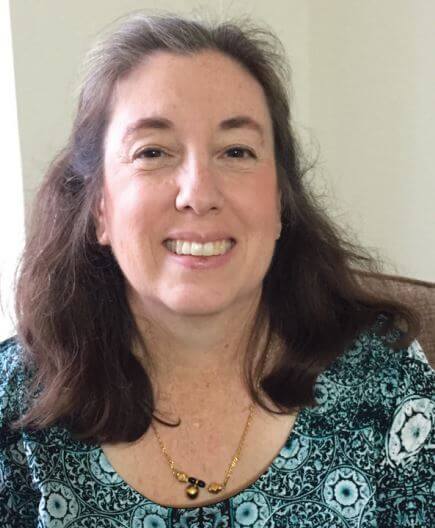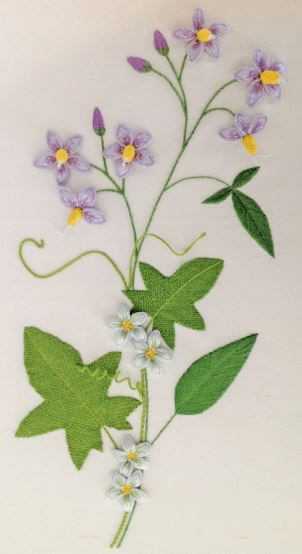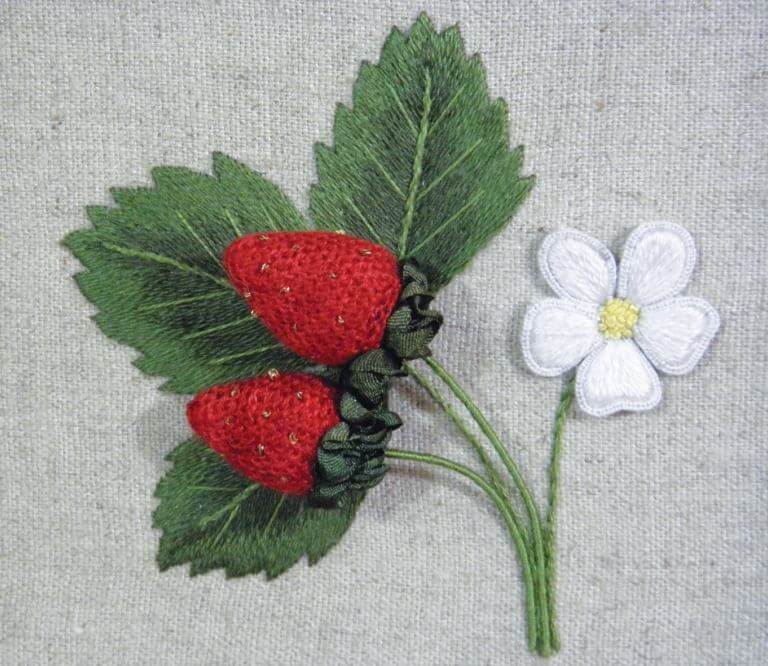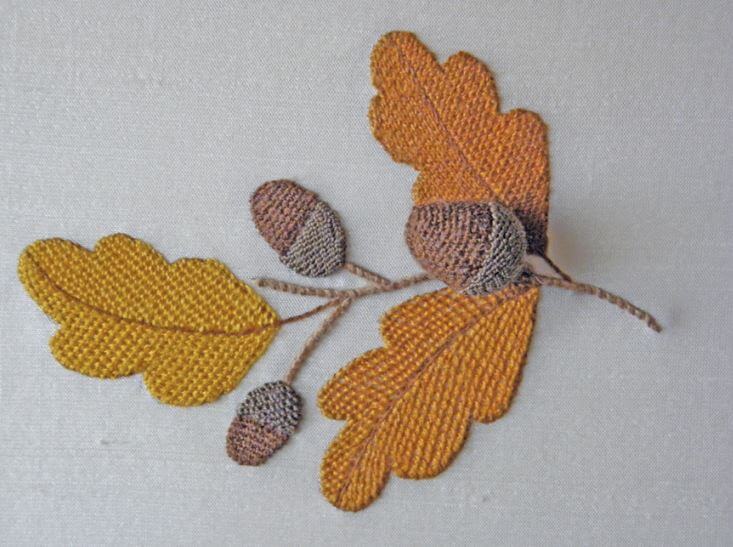Celeste Chalasani
This is an excerpt of a profile that originally appeared in the March 2015 issue of Needle Arts magazine.

Celeste Chalasani found a new focus for her stitching life after discovering a new stumpwork book. She said, “Shortly after I joined EGA in 1999, a member brought Jane Nicholas’ Stumpwork Embroidery to a meeting. I didn’t know embroidery like that existed, and it captivated me. If the bookstore had been open late, I probably would have stopped to buy one on the way home.” She did buy it, as well as Nicholas’ Stumpwork Embroidery Designs, within the week, and she’s been hooked ever since. After reading the books cover to cover, she realized that she needed to improve her embroidery skills before tackling Nicholas’ intricate designs.
Chalasani related, “When I joined EGA, I faced a big learning curve. I had only a very basic knowledge of embroidery stitches.” As a child, she
had embroidered stamped pillow cases with her grandmother and worked counted cross stitch on Aida. With young children and work commitments, fifteen years had passed since she had finished her last needlework project. But she was passionate about learning stumpwork, so she planned how she could acquire the skills she needed. She said, “The things that allowed me to improve my skills were joining EGA’s CyberStitchers as a plural member, subscribing to Inspirations magazine, taking EGA’s Jacobean Crewel Individual Correspondence Course (ICC), and enrolling in City & Guilds distance courses in England.” (Continue reading below)
Joining CyberStitchers allowed Chalasani to sign up for many Group Correspondence Courses. She took as many GCCs as she could. She found they gave her good exposure to specific techniques, and she appreciated the teachers’ feedback. The courses she enjoyed most focused on Mountmellick and Casalguidi.
My subscription to Inspirations started as a fluke. Chalasani explained: My husband was in Sydney, Australia, on business in 2001, and I asked him to bring me something that was related to embroidery. He brought me an issue of the magazine that he found in a needlework store. If he had known what kind of obsession he was starting, I’m sure he wouldn’t have brought it back! Publications in the United States focused on cross stitch, but this magazine featured beautiful surface embroidery projects in many techniques. They were finished as items to be used instead of just framed pieces. I’ve done a lot of projects from Inspirations.
In 2002 she signed up for the ICC in Jacobean crewel with Judy Jeroy, who was teaching from a text written by Mary-Dick Digges. Chalasani said, “Working one on one with a teacher made a huge difference in improving my skills. Jeroy looked at my stitches and told me what I did well and what I needed to improve.”
In 2003, Chalasani attended her first EGA National Seminar in Rye, New York, taking a dragonfly stumpwork class from Jane Nicholas. She observed: I had stitched some small stumpwork projects by then but I still considered myself to be a novice. Everyone else in the class seemed to know what they were doing, and I worked very hard to keep up. Jane was such a patient and wonderful teacher. I came away feeling more confident, as if all the mysteries of life were unveiled in that class. I’ve taken four more classes with her since then. I especially remember one workshop (Corncockle and Dragonfly) in which a particularly difficult technique was used. I was struggling a bit, and she could have said I was doing okay. But as I worked on it, she’d say, “You can do better than that.” So I’d take out the stitching and try again until finally she said, “Yes, that’s perfect.” That exchange taught me that sometimes you have to rip out your stitching and keep trying until you get it right and that in doing so you will be happier for it.(Continue reading below)
In 2008, Chalasani enrolled in City & Guilds’ (C&G) stumpwork courses after reading a CyberStitcher’s post about the program. The vocational school, based in London, offers training in fields ranging from construction to arts and crafts. She said, “I don’t believe the courses improved my embroidery skills per se, but they taught me to design and to THINK. There was a minimal amount of instruction. For instance, the requirement would be to produce a wired slip, and the instructions would read, “Go out to the garden, pick a flower, pull off the petals, and trace around them on paper.” You’d then proceed to match threads to the petal and decide how to stitch it. You had to figure out most of it on your own. Before these courses, I had changed motifs or colors in existing patterns, but the C&G courses forced me to begin designing my own pieces. My early designs were clumsy, but as I progressed, I began to see that I could take an idea and make it real. It was liberating”
Now that she is more comfortable designing, her inspiration comes in a variety of ways. Berry Bramble came about from a conversation. She explained, “While I was teaching a workshop for a local chapter, my friend, Melinda Rolfe, said I should do something with berries, and I asked her if she meant like a bramble. The word bramble stuck in my head and it eventually became a design and a teaching piece.”

Bryony and Bittersweet evolved from 450 Fleurs (450 Flowers), a book of flowers of the French Alps. While studying in Grenoble, France, Chalasani’s daughter had sent her the book. Chalasani was drawn to the photo of douce-amère (bittersweet) which she had also seen depicted in Michele Bilmoff’s book of flowers, Promenade dans de les Jardins Disparus (A Walk in Vanished Gardens), featuring reproductions of artwork found in the medieval illuminated codices of the book of hours for Anne d’Bretagne. Chalasani said, “My daughter translated both books for me. I learned that the berries of both bittersweet and bryony are toxic. That connection intrigued me and led to my design of what I call a deadly duo.”
Chalasani has a personal connection to India, and the Indian motifs that she incorporates in some of her designs have special meaning to her. Her husband was born and raised in the state of Andhra Pradesh. She made her first trip to India twenty-six years ago, and she has visited many times since then. She explained, “I think everyone has a place that pulls at their heart. India is one of those places for me. The heat, the poverty, and the sanitation problems make it one of the most difficult places to visit. At the same time, the countryside is beautiful and peaceful and the people are friendly, helpful, generous, and loving. In the marketplace, I’ve been inspired seeing all the beautiful women in bright silk saris, with the light playing off the jeri (gold) borders and the bright glass and gold bangles, heavy necklaces, and dangly earrings. As difficult as it is, I always come home saying, ‘So when are we going again?'”
Indian Summer was inspired by traditional mehendi (henna) designs. Henna is made into a paste and applied to the hands and feet of women for weddings and religious festivals. When Chalasani married, her name and her husband’s name were incorporated into the designs. She explains, “Did you ever doodle when you were young while sitting through a boring class or lecture? That’s what the designs remind me of. The artist starts with a basic design, perhaps a flower or a peacock and then keeps adding details to it with leaves, scrolls and dots until the entire hand or foot is covered.”
Chalasani loves the flowers of India. Bright orange marigolds and chrysanthemums, used in religious ceremonies, populate Grandma Grew Chrysanthemums, Indian Summer, and La Dia de los Muertos.
She said, “The vast majority of my pieces use bright colors such as those you see in Beautiful Demoiselle, Bryony and Bittersweet, Buttercups and Bellflowers, and In the Garden. My next challenge will be to find a way to stitch the many fragrant tubular-shaped flowers in bright colors.”
Chalasani continues to look to Indian flora for her designs. “Kari (curry) leaves are essential to South Indian cooking,” she states. “I grow them at home, and I have seen them bloom and develop seed pods for the last two summers. They will probably show up in my designs soon.”
She has stitched white flowers to represent jasmine in Indian Summer and Jasmine Delight. Jasmine abound in India and are quite diverse. “Their fragrance is intoxicating,” she commented. “The tiny variety is used in religious ceremonies. Sometimes the flowers are used loose, and sometimes they are tied into leis either by themselves or with other flowers. A larger variety is tied into a small lei and worn in women’s hair. Some varieties are pure white and some are white and pink. Some varieties grow in bushes and some are on vines. Some are more fragrant in the morning and some in the evening.”
Chalasani finds inspiration from other sources. She said, I take photos of things that catch my eye, such as flowers planted along the sidewalk in Berkeley, California; labels with interesting graphics; doorways; window frames; embroidery; and paintings and codices in museums. Sometimes a design comes about because a flower I see would make a unique project. I like the puzzle of figuring out how to stitch flowers with unusual petals, stamens, and leaves. An idea stays in my subconscious, and I’ll mull a bit until I wake up one morning with the plan of how to stitch it. (Continue reading below)
Celeste began to teach stumpwork because she saw a need for beginning-level classes. She said, “Most stumpwork classes at national seminars are for embroiderers who are familiar with the technique. I wondered how you learn a technique if no one in your chapter or region teaches it.” Most of her classes are open to students at all levels. She said, Teaching that way is hard, but I’ve adapted the way I teach so that every student can learn, whether they have never done any surface embroidery or are at an intermediate or advanced level in stumpwork. I teach the way I would want a class taught if I were the student. I try to be generous with my time, with how I kit, and with what I have learned. Stumpwork is a slow method of stitching; there isn’t any instant gratification. My projects won’t be finished during class, so it’s important to me that students understand the techniques in class so they can finish the project at home. A seminar may be a student’s only vacation, and a student may have had to save up for months to be able to afford to take the class, so my philosophy is that I better give 110% of myself every minute of class so that everyone leaves happy.

Chalasani loves stumpwork because it incorporates techniques used in other forms of embroidery. “If you look at seventeenth-century raised embroidery,” Chalasani said, “the embroiderers pulled together every technique they knew for their caskets. They used silk shading to stitch flora and fauna and tent stitch for grass knolls. Three-dimensional flowers and insects were created using various forms of needlelace, and figures wore dresses stitched in blackwork.”
Chalasani observed that contemporary stumpwork continues to be multi-faceted and still shares much in common with other techniques. Line stitches, such as backstitch, outline, stem, and split stitch, that are commonly used in crewel, Madeira, and Mountmellick define stems and scrolls. Silk-shaded leaves and flowers are found in crewelwork and thread painting. Dimensional stitches, such as raised stem stitch that are used in Casalguidi, create caterpillars. We add texture with French knots, beads, and silk ribbon, just as embroiderers do in surface embroidery, bead embroidery, and ribbonwork. We give our pieces bling and so incorporate goldwork techniques. We even attach found objects to our pieces using Shisha embroidery. So when someone says to me, “Oh, stumpwork, is that all you teach?” I have to laugh because anyone who does stumpwork embroidery knows so much more than “just stumpwork”!
Chalasani believes embroiderers should never stop trying to learn new things. She encourages EGA members to apply for the Mary-Dick Digges Scholarship. She applied for it, won, and in 2013, she was able to take a class at seminar in Louisville with Jane Nicholas.
Chalasani has a bucket list of embroidery techniques to learn. She would like to study Japanese beading and thread painting. She also wants to learn to use a tambour hook. She noted that her dream trip would be to take a class at Ecole Lesage in Paris, France.
During her last trip to India in the summer of 2013, she purchased silk thread she hopes to use in her work. She said, “It’s a flat silk, which I’ve never worked with. The colors are bright, so I’ll need to design pieces with elements that will work with that palette. I have a feeling that they’ll be more appropriate for making insects rather than flowers; I’ve been meaning to design more bugs, so that could be interesting.”
Chalasani also benefits from a support group. She observed, “Artists need the encouragement of fellow artists. Other artists are also creating projects, and meeting with them provides an artist with a different perspective and helps him or her start to look at things differently.” Chalasani and two friends from her chapter, Linda Casey and Sheila Iskin, meet monthly to encourage one another in their art. Their skills overlap and blend, and they trust one another’s judgments.
During one of these meetings, Casey encouraged Chalasani to develop a class on technique rather than a project. “I developed the curriculum Basic Stumpwork Techniques for anyone new to stumpwork or for someone who has done stumpwork but wants to work on technique,” Chalasani explained. “Maybe you’ve bought a book, and you want to stitch projects out of it, but you’re not sure how to start. Or you’re a canvas person and want to embellish your pieces with stumpwork. Or you just want to learn something new without the guilt of having another project from seminar to finish. This class is for all these people and more.”
At National Seminar 2015, Chalasani will be teaching this class as well as Needlelace Primer, a one-day class using detached buttonhole stitch, and a two day class, Bryony and Bittersweet.
Chalasani has also developed a six-lesson stumpwork ICC. The lessons cover the essential elements of stumpwork embroidery: dimensional stitches, padded and wired slips, needlelace, and stumpwork figures. She has designed several projects for the ICC including Grazing Sheep, Flax, Acorns and Oak Leaves, The Ballerina, and The Summer Vegetable Sampler but students may stitch designs of their own choosing instead.
As is often the case with teachers of needlework, she rarely has time to work on pieces for herself. A few years ago, however, she purchased a five-opening dowry box from Olde Colonial Designs and has started to design the panels.
She sketched the side panels to tell the story of St. George and the dragon. She has completed two sides, one of which is a dragon, published in the March/April 2013 issue of Piecework. For the top, she plans to feature St. George on a white horse, slaying the dragon, with a princess to one side, and the castle in the background.
To see more of Celeste Chalasani’s designs, visit her website, celestechalasani.com.
Profile by Cheryl Christian, Needle Arts Editor

Needle Arts Magazine
Read Celeste's full profile from Needle Arts magazine in the link below.